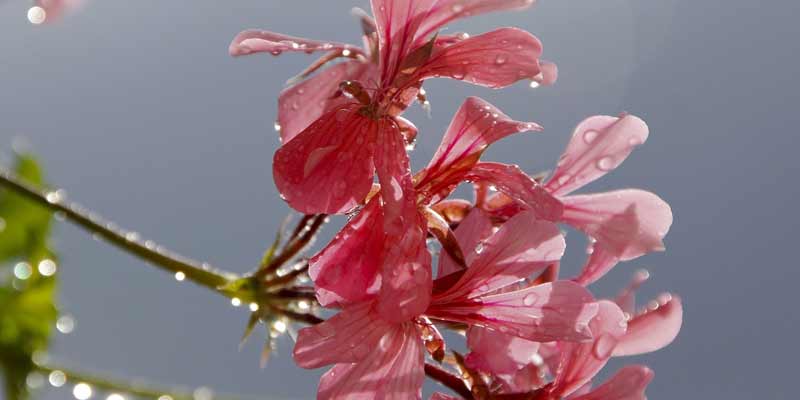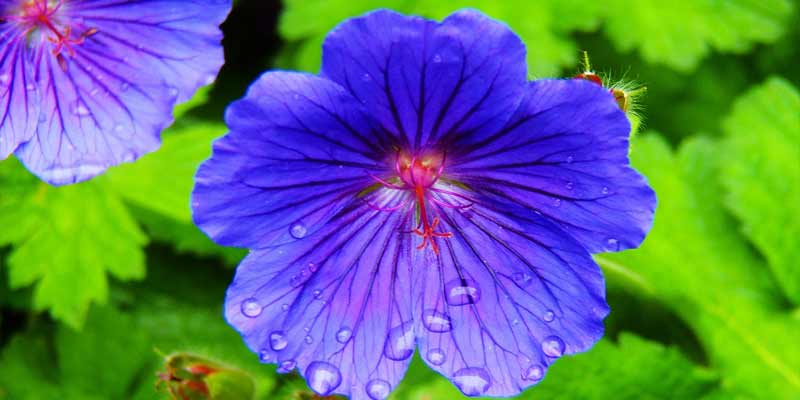Worldwide, gardeners and enthusiasts cherish geraniums for their vibrant colors and aromatic foliage. Renowned for resilience and beauty, these versatile plants flourish in a variety of climates and conditions. Like all plants though, geraniums need proper care to thrive; crucially, this maintenance includes appropriate watering.
This detailed guide delves into the art of watering geraniums. It explores optimal frequency for this crucial task, a key factor in their growth and abundant blooms.
Understanding Geranium Watering Needs
Understanding the specific requirements of geraniums and the factors that influence their moisture needs is essential before we discuss watering frequency.
Soil Type and Drainage
Well-drained soil, which facilitates the free escape of excess water, provides an ideal environment for thriving geraniums. Geraniums favor a soil pH level that ranges from slightly acidic to neutral and they adapt well to different soil types – such as loam, sandy, or clay.
Nonetheless, excessive moisture retention within the earth can trigger root rot along with various other complications. When you amend the soil with organic matter compost or peat moss, for instance, this action enhances drainage and soil structure.
Consequently, it promotes robust root growth.
Climate and Environmental Conditions
Temperature, humidity, and sunlight exposure are the environmental factors that shape geraniums’ watering requirements. Geraniums in hot, arid climates may demand more frequent watering to stave off dehydration and heat stress
However, with cooler temperatures coupled with elevated humidity levels, the need for regular irrigation could diminish. Geraniums cultivated in containers or hanging baskets may experience accelerated dehydration compared to their counterparts rooted in the ground. This necessitates meticulous monitoring of water requirements.
Establishment Phase vs. Established Plants
Regular watering is crucial for newly planted geraniums to develop a robust root system and adapt to their fresh environment. Throughout the establishment phase, maintaining the soil’s moisture at an even level – without saturating it with water – proves vital.
Typically after the initial few weeks of growth signify geraniums’ establishment; subsequently, they exhibit increased tolerance towards drought conditions and necessitate less frequent watering.
However, consistent moisture is still essential, especially during periods of active growth and flowering.
Container vs. Ground Plantings
Container-grown geraniums, unlike those directly planted in the ground, experience limited access to soil moisture; they may dry out more rapidly, particularly amidst hot weather conditions. Maintain a close monitoring  of container moisture levels and apply water judiciously as this will ensure the soil remains evenly moist.
of container moisture levels and apply water judiciously as this will ensure the soil remains evenly moist.
Deeper, less frequent watering sessions that effectively penetrate the root zone offer advantages to ground-planted geraniums.
Determining the Ideal Watering Frequency
Having delved into the factors that influence geranium watering, we now turn to a discussion on the optimal frequency of geranium hydration for ensuring their robust health and vitality; indeed an essential topic in successful plant care.
Visual Soil Inspection
To gauge the optimal watering time for geraniums, employ a simple and effective approach, to visually inspect the soil.
Here’s how to do it correctly: insert your finger into the soil near to base of the plant; this allows you to assess its moisture level. When several inches below the surface, if you perceive dryness on touch – it signifies that it is now time for watering. If the soil retains moisture, refrain from watering to prevent potential issues such as root rot and other problems associated with excessive moisture.
Watering Schedule
To maintain consistent soil moisture levels and avert drought stress in geraniums, it is crucial to establish an organized watering schedule. Strive for deep yet infrequent watering; let the soil dry out marginally between each session.
Throughout the growing season, generally, from spring until fall, you might need to intensify your frequency of irrigation so as to bolster vigorous growth and promote blooming in geraniums. Monitor weather conditions and adjust your watering frequency accordingly.
Morning Watering
By watering geraniums in the morning, we enable their foliage to dry rapidly; this action mitigates potential risks of fungal diseases, specifically, powdery mildew. It is crucial to note that late evening waterings must be avoided as these can promote disease development due to overnight moisture retention on wet leaves.
Moreover—when one practices morning irrigation—it guarantees that plants secure a source of hydration amidst peak daytime heat: a strategy that not only reduces stress but also enhances growth optimization.
Mulching and Soil Moisture Retention
By applying a layer of organic mulch – like shredded bark or compost – around the base of geranium plants, one can significantly conserve soil moisture; regulate temperature fluctuations; and suppress weed growth.
Moreover, this practice improves soil structure and fertility over time: thus creating an ideal environment for robust root development.
Conclusion
Understanding the unique watering needs of geraniums and monitoring environmental factors are crucial steps towards establishing robust growth, abundant blooms, and overall plant health; thus illustrating how essential proper watering is for your garden or landscape’s vitality.
By providing care, and meticulous attention to detail in particular, you can encourage colorful blossoms from your geraniums along with aromatic foliage that will serve as charming additions brightening outdoor spaces with beauty.


Leave a Reply